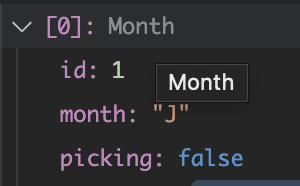Bonjour à tous,
Je butte sur un problème de mes tests auto. L’attendu et le résultat sont les mêmes mais il me dit qu’il y a une erreur. Quelqu’un saurait d’où ca peut venir ?
TestFailure (Expected: [
Instance of 'Month',
Instance of 'Month',
Instance of 'Month',
Instance of 'Month',
Instance of 'Month',
Instance of 'Month',
Instance of 'Month',
Instance of 'Month',
Instance of 'Month',
Instance of 'Month',
Instance of 'Month',
Instance of 'Month'
]
Actual: [
Instance of 'Month',
Instance of 'Month',
Instance of 'Month',
Instance of 'Month',
Instance of 'Month',
Instance of 'Month',
Instance of 'Month',
Instance of 'Month',
Instance of 'Month',
Instance of 'Month',
Instance of 'Month',
Instance of 'Month'
]
Which: at location [0] is <Instance of 'Month'> instead of <Instance of 'Month'>
Pendant le débug avant le crash :

et le test :
Month(id: 1, month: "J", picking: false)
Merci d’avance !!
